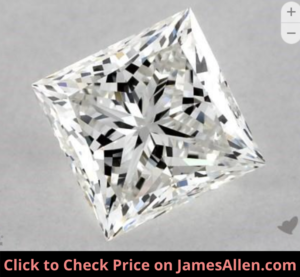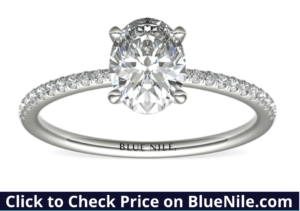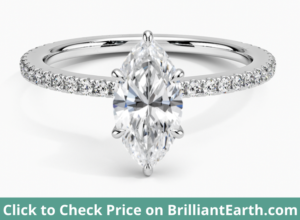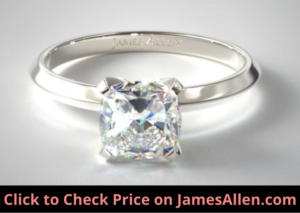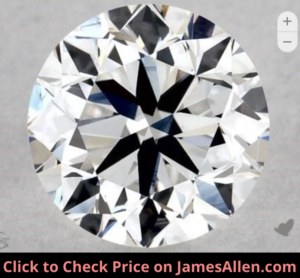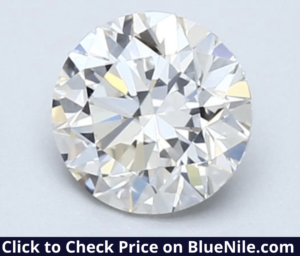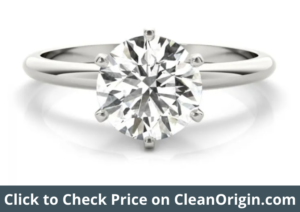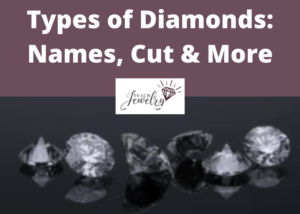
If you’re exploring pieces of jewelry, it’s important to know the different types of diamonds.
Your selection impacts its overall performance, which includes the diamond’s visible appearance, brilliance, and durability.
Diamonds are categorized in many ways, from the initial classification system to its shape, clarity grade, cut, source, and more.
I’ll detail all the diamond types and what to know about them, so you’ll have the confidence to choose the right one for you.
Classification System
At a high level, diamonds are classified according to their chemical and physical traits.
They’re composed of carbon, but some have trace elements of boron or nitrogen that developed during their formation. In other cases, these elements are added in a laboratory to change its appearance and structure.
According to the Gemological Institute of America, gemologists began categorizing diamonds to describe their atomic structure and chemical composition, labeling them as type I or type II.
This classification system has since been divided into four groups: Ia, IIa, Ib, and IIb.
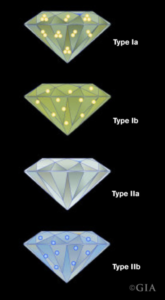
Type Ia
Ninety-five percent of diamonds on the market are type Ia. There are clusters of nitrogen atoms that result in the diamond appearing near-colorless or slightly yellow.
Type IIa
Type IIa diamonds have no impurities from nitrogen or boron. Chemically pure, they often appear colorless or near colorless. When they have shades of color, the tints are light yellow, pink, brown, or gray. Less than two percent of earth-grown diamonds are type IIa.
Type Ib
Type Ib diamonds are often referred to as “canary.” This bright yellow gem contains isolated atoms of nitrogen scattered around the stone, which results in the rare color.
Type IIb
This diamond type is also rare but features no nitrogen atoms. Instead, its carbon structure contains only boron. This combination often causes these stones to appear bluish or gray.
You won’t come across this terminology at most diamond retailers or on grading reports. It’s a classification system used by gemologists, but it isn’t as important during the buying process.
All the categories we’ll discuss next are ones you need to know when searching for the right one.
Types of Fancy Cut Diamonds
Round cut diamonds are the most popular, but if you’re interested in an alternative shape, you should consider a fancy cut. These diamonds are often named after the shape they resemble.
Each has unique qualities that differentiate it from a traditional diamond, both in its appearance and overall performance as part of a ring.
Here’s a brief description of these types of diamonds.
Princess
Princess cut diamonds are known for their squarish shape and brilliant cut facets. That’s why they’re also called “square modified brilliants.” They’re the second most popular cut for engagement rings behind round cuts.
Emerald
Emerald cuts have an elongated shape and four cropped corners. Step-cut facets run parallel across its table. Instead of strong brilliance, it produces a warm, subtle glow.
It appears larger than many cuts of the same carat weight because of its wide surface area. They generally aren’t a popular choice for engagement rings because most buyers value brilliance.
But I conducted research on celebrity engagement rings by evaluating the cut of 250 of them. Emerald cuts ranked third with 44 out of 250, behind only round (74) and oval (45).
Oval
Oval cuts mimic the shape of round cuts but are stretched to create a longer diamond. Their brilliance doesn’t match round cuts, but it still has plenty of sparkle.
For engagement rings, oval cuts are often the sixth most popular cut because most buyers interested in the rounded edges instead choose a round cut.
Even though oval cuts appear similar to round diamonds, the difference is often apparent when viewed in a normal setting.
Baguette
Baguette cut diamonds are rarely used in diamond rings. Its shape is similar to an emerald cut, but the corners aren’t cropped. You’ll often see them in settings as tapered baguettes, where two flank either side of the main gem.
It’s one of my favorite styles of settings because they complement the round diamond and add a sense of elegance.
Pear
Pear cuts resemble the shape of a tear-drop because one end is rounded and the other comes to a sharp point. The 58 brilliant cut facets exhibit strong fire and brilliance, so they fit as the centerpiece in diamond rings.
Marquise
Marquise cuts are shaped like an eye. The ideal length to width ratio falls between 1.75 and 2.15, so it doesn’t appear too stretched or condensed. As a modified brilliant cut, its facets are a similar style as round cuts that effectively capture and reflect light.
Heart
Heart cuts are named after their shape. It’s rare for diamond rings to feature heart-shaped diamonds. In fact, less than one percent of diamonds are cut into this design. If you’re considering a heart cut, opt for a length to width ratio as close to 1.00 as you can find.
Asscher
An Asscher cut has a square shape with a deep pavilion and cropped corners. The 58-step cut facets don’t have strong brilliance but instead create a layered, “hall” of mirrors” effect.
Its shape is close to an emerald cut, but the square outline distinguishes it from the rectangular emerald.
Radiant
Radiant cuts are another type of diamond that have a square or rectangular shape. It’s comparable to a princess or cushion cut, and one of the pros of radiant cuts is brilliant-cut facets.
Expect enough sparkle to disguise some inclusions, so you can choose a lower clarity grade than diamonds with step-cut facets.
Cushion
Cushion cuts have a pillow-like shape, often with 58-64 facets. In fact, there are multiple types of cushion cuts: old mine and modern, standard and modified, chunky and crushed ice, and rectangular and square. Each can fit as an engagement ring diamond, especially with a halo of smaller gems around it.
Clarity Grades
Another classification for diamonds is clarity grade. It indicates the presence of inclusions, or blemishes, within its facets that developed during its formation.

Examples include:
- Feathers
- Etch channels
- Indented naturals
- Twinning wisps
Most organizations that certify the quality of diamonds use the following scale:
Flawless (FL)
This type of diamond has no imperfections visible at 10x magnification on its surface or inside the facets. All diamonds develop some clarity characteristics under the intense heat and pressure, but these earn the top grade because it requires more than 10x magnification to see them.
Internally Flawless (IF)
Internally flawless diamonds have no inclusions visible at 10x magnification but do have flaws such as surface graining. On the GIA report, you might see a phrase like “minor details of polish are not shown.”
To the naked eye, IF diamonds generally appear identical to FL.
Very, Very Slightly Included (VVS)
This clarity grade is divided into VVS1 and VVS2. VVS1 diamonds have inclusions that are difficult to identify with a jewelers loupe. The VVS2 designation means they’re slightly easier to pinpoint than VVS1.
Very Slightly Included (VS)
VS, both VS1 and VS2, is a type of diamond with inclusions that are noticeable with magnification but rarely to the naked eye.
Check out the example below.
They’re a common pick for engagement rings because you avoid the premium prices for higher clarity grades, but they often look flawless without magnification.
For my wife’s engagement ring, I landed on a VS1 diamond for that exact reason. I was able to choose a higher carat weight that I would have if the diamond were VVS, IF, or FL.
Slightly Included (SI)
Slightly included diamonds (SI1 and SI2) is a misnomer because this clarity grade indicates the presence of significant inclusions.
There are often three to five types such as twinning wisps, etch channels, and feathers.
Some are eye-clean but others have noticeable blemishes, so you should always view them in-person or through high-resolutions images before deciding on one.
I actually recommend starting your search for an engagement ring diamond at SI1 clarity if it’s less than one-carat. You’ll often have to move up to VS2 or VS1 to find the right one, but if you find an eye-clean SI1 diamond, it can offer exceptional value.
Included
Included diamonds are graded I1, I2, or I3. Unless they’re less than 0.5 carats, the inclusions are highly visible. We don’t recommend included diamonds for engagement rings because it will have diminished brilliance and durability in addition to noticeable flaws.
Clarity is one of the most important aspects of a diamond to consider because black spots, a dark twinning wisp, or a feather can negatively affect its appearance, no matter its quality in other areas.
Cut Grades
A diamond’s cut is the factor that most impacts its brilliance. Gemologists base the overall cut grade on factors such as:
- Symmetry: the alignment and shape of facets
- Polish: the smoothness of its surface
- Proportions: the ratio of its width, depth, and table
- Girdle thickness: the width of the girdle that connects the crown and pavilion
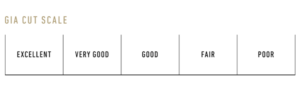
Combined, diamonds are assigned one of the following cut grades:
Excellent (EX)
Excellent cut diamonds are the type with the highest amount of brilliance, fire, and scintillation.
Its symmetry, polish, and proportions maximize light performance, where it collects light, bounces it around inside the facets, and returns it to the viewer without it leaking through the pavilion.
Although you’ll pay a premium for an excellent cut grade, I think it’s worth it. I chose an excellent cut diamond for my wife, and the brilliance is outstanding.
Very Good (VG)
Very good diamonds also show strong sparkle, but they may not have excellent grades in areas like polish and symmetry. To the naked eye, the difference in brilliance between a very good and excellent cut isn’t always noticeable.
This is the minimum cut grade I recommend choosing for a center diamond, but you should opt for an excellent cut.
Good (G)
Diamonds with a good cut grade may exhibit some brilliance, but the difference between them and excellent cuts is noticeable. It may have misaligned facets resulting in a good symmetry grade or some roughness that lowers the quality of its polish.
Fair (F)
Fair cut diamonds have little brilliance. They’re sufficient for small diamond accents, but don’t choose fair cuts for the main diamond. Light will leak from multiple places, and its misaligned facets, rough surface, or extremely thin girdle could add to the problem.
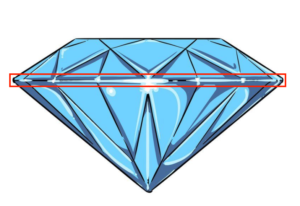
Poor (P)
A poor cut is a type of diamond that will show almost no glimmer. Light escapes from everywhere, the facets aren’t symmetrical, and they don’t have a smooth surface. Avoid poor cut diamonds because they’ll have a negative effect on your jewelry, even if they’re small.
As you can see, cut is a quality where you should avoid compromising. There’s a noticeable distinction between most cut grades, which isn’t the case with some other aspects of a diamond.
Color Grades
When buyers are searching for the right diamond type, they often search for colorless ones. They’re the most valuable because tints of yellow and brown diminish its brilliance and aesthetic appeal.
The GIA developed a color scale ranging from D to Z. Diamonds with a D color grade are colorless, while Z means it’s heavily colored, usually appearing brown or dark yellow.
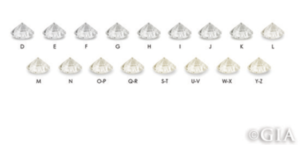
These color grades are broken down into the following categories:
Colorless (D-F)
Diamonds graded D, E, or F are named colorless. They almost always appear that way to the naked eye, so it’s difficult to tell the difference between the three grades.
In most cases, you should avoid the premiums for a D or E color diamond but you often can’t tell the difference between them and lower grades.
Near colorless (G-J)
Near colorless diamonds sometimes have noticeable color, unless it’s below one carat. These smaller diamonds may appear similar to colorless ones, which means you can avoid paying a premium for one in that category. As you move for G and H to I and J, the color becomes more visible.
Faint (K-M)
Faint diamonds almost always have visible yellow shades, even if it’s a smaller round cut. Not only is the yellow less visually appealing, it won’t have the brilliance of those that earned higher grades.
Very light (N-R)
A very light diamond has a strong color, so it’s not the type of diamond you’d want as the center stone on a ring. Most prominent diamond retailers like James Allen and Blue Nile don’t list them in their inventories.
Light (S-Z)
Light diamonds have a strong yellow tint and border on appearing brown. These diamonds aren’t used in quality jewelry, and it’d be difficult to find them listed as loose diamonds from popular vendors.
Although most buyers choose near colorless or colorless diamonds, there are also diamonds with strong shades of other colors such as:
- Pink
- Blue
- Green
- Champagne
- Orange
- Purple
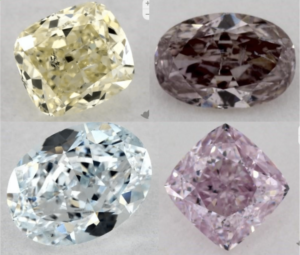
While they typically aren’t used in engagement rings, there are other pieces of jewelry, like necklaces, bracelets, and earrings, where these diamonds are popular.
These diamonds are named after their most prominent color. Quality is measured with different criteria from colorless diamonds, so one of your options is the intensity of the color.
For example, Brilliant Earth sells pink diamonds on a scale from faint to dark, with categories like very light, intense, and deep in between.
Whether you choose a colored or colorless diamond is a foundational decision, so you should decide early on which direction you’ll go.
From there, you can pick its exact qualities related to clarity, carat weight, or the intensity of the color.
Natural, Treated, and Lab-Created
Another way to classify diamond types is whether it’s natural, treated, or lab-created.
Natural diamonds are the most popular on the market. They’re mined in places around the world like Botswana, Canada, and Australia.
Natural diamonds are also the most expensive because quality ones are rare. Most have developed significant inclusions or have shades of yellow, so they aren’t worth as much.
There’s also high demand for natural diamonds compared to the other types.
Treated diamonds are referred to as clarity-enhanced. They’re natural diamonds that had visible imperfections, so jewelers corrected those flaws through artificial means.
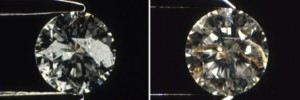
This often takes the form of removing dark inclusions from within the facets or removing color.
While these treatments can improve its final form, they’re worth less than identical natural ones. In general, clarity-enhancement transforms its visible appearance, but that doesn’t equate to an increase in value.
Lab-grown diamonds, also called synthetic diamonds, have the same chemical structure as natural ones. The creation process mimics what diamonds experience as they’re formed under the earth.
The naked eye can’t tell the difference between the two stones. Gemologists have to use special equipment to learn if it’s real or lab-grown.
Another pro of lab-created diamonds is they sell for close to half the cost. The savings allow you to choose a higher clarity, cut, or color grade, or a larger stone, for the same cost as a natural one.
The market has grown as buyers are more conscious about the environmental impacts of mining.
Of the three types, I recommend choosing a natural or lab-created diamond. Avoid ones that have been treated.
Clarity-enhancement procedures may disguise blemishes, but you’re better off choosing a quality diamond without those treatments.
What Type of Diamond is Right For You?
Diamonds are named in a number of ways, which means the right type of diamond for you spans across many of these categories.
For engagement rings, most buyers consider type Ia diamonds with high grades across clarity and cut that also don’t show color. That’s true whether it’s natural or created in a lab.
No matter what type of diamond you choose, you’ll find the right one for your piece of jewelry.

Jacob Clarke
Jacob Clarke is the founder of TeachJewelry.com.
He earned an Applied Jewelry Professional Diploma from the Gemological Institute of America (GIA) and now brings you essential information about diamonds, settings, and more.
Jacob has consulted with leading jewelry brands, and his work has been cited in Clean Origin, Diamond Nexus and industry publications.
He's also a member of the International Gem Society.
He enjoys discussing jewelry with readers, so contact him with any questions at jacob.clarke@teachjewelry.com.

